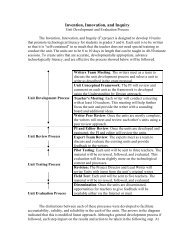May/June 2009 - International Technology and Engineering ...
May/June 2009 - International Technology and Engineering ...
May/June 2009 - International Technology and Engineering ...
Create successful ePaper yourself
Turn your PDF publications into a flip-book with our unique Google optimized e-Paper software.
Resources in <strong>Technology</strong><br />
Discovery of the Depths<br />
By Petros J. Katsioloudis<br />
The world’s oceans have been almost<br />
impenetrable to human exploration<br />
because of obstacles associated with<br />
underwater exploration—until the<br />
very recent development of remote<br />
underwater vehicles.<br />
More than 70 percent of earth’s surface is liquid water,<br />
most of it sparkling blue oceans that cover nearly<br />
140 million square miles of Earth, a greater area<br />
than all continents combined (McMillan & Musick,<br />
2007). Despite the large amount of earth that oceans cover,<br />
the world’s oceans have been almost impenetrable to human<br />
exploration because of obstacles associated with underwater<br />
exploration—until the very recent development of remote<br />
underwater vehicles (Ramaswamy, 2002). Factors such as the<br />
high cost of employing commercial divers for underwater<br />
exploration <strong>and</strong> inspection of pipelines, platforms, <strong>and</strong> other<br />
marine installations led to the development of remotely<br />
operated underwater vehicles (ROVs). Generally divers<br />
reach depths close to 1500 feet, whereas the ROVs descend<br />
to anywhere between 6000 to 20,000 feet, depending on<br />
the degree of sophistication of the vehicle to perform<br />
complex operations (MacFarlane & Petters, 1986). Remotely<br />
operated vehicles have been used for various tasks including<br />
inspection, recovery, <strong>and</strong> construction.<br />
Autonomous Underwater Vehicle ABE (Autonomous Benthic<br />
Explorer) is launched over the side of a research vessel. ABE will be<br />
used to collect high-resolution multibeam bathymetry at Explorer<br />
Ridge, as well as a CTD <strong>and</strong> magnetometer.<br />
According to Narayan (2002), there are different systems<br />
available for underwater exploration. The major systems<br />
include: (a) wet diving such as scuba, bounce, <strong>and</strong><br />
saturation diving; (b) one-atmosphere manned vehicles with<br />
manipulators <strong>and</strong> cameras, either tethered or autonomous;<br />
<strong>and</strong> (c) remotely operated vehicles (ROVs) with manipulators<br />
<strong>and</strong> cameras, either tethered or untethered. Tethered<br />
ROVs are attached to a support ship by an umbilical cable<br />
that relays control signals <strong>and</strong> power down to the vehicle<br />
<strong>and</strong> returns images <strong>and</strong> sensor data to the main computer<br />
on the mother ship. The ROV is controlled by an operator<br />
Credit: National Oceanic <strong>and</strong> Atmospheric Administration (NOAA)<br />
12 • The <strong>Technology</strong> Teacher • <strong>May</strong>/<strong>June</strong> <strong>2009</strong>
















